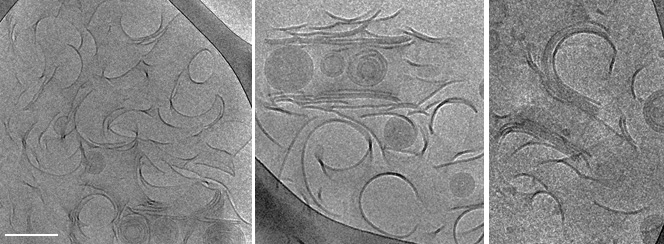Mechanistic aspects in the self-assembly of lipids into nano- and microtubesb
The self-assembly of biological and synthetic based lipids into micro- and nano- structures has been the subject of intense study in past years, both for basic research and for potential applications. Lipids as phosphatidylcholine (PC), phosphatidylethanolamine (PE) and phosphatidylserines (PS) that are common in the plasma membranes, can exhibit a variety of lamellar phases in aqueous solution. Some of them as well as synthetic or mixed-lipid systems can form chiral aggregates in the form of cylindrical tubes, to minimize their free energy requirement. Luba’s research focuses on the self-assembly of 1,2-bis(10,12-tricosadiynoyl)-sn-glycero-3-phosphocholine (DC8,9PC), a synthetic lipid comprising diacetylene moieties in its tail, which presents a distinct aggregation behavior into multilamellar structures. Using advanced electron microscopy techniques as the main research tools, we were able to follow the evolution and maturation of the structures into tubes.
Figure: Intermediate twisted, curled and stacked membrane fragments formed from DC8,9PC in 70% EtOH/ 30% H2O, during a fast cooling process 25°C.
Nanostructure and mechanism of one-dimensional self-assembly of amphiphilic molecules
Under the wide scope of self-assembly, there are certain types of structures which are much less understood than others. One such class of structures comprises 1-dimensional (1-D) assemblies, which encompass fibers, ribbons and tubes. 1-D structures can be associated with many human amyloid diseases, including Alzheimer, type II diabetes and multiple sclerosis, and also with processes like collagen self-organization into triple helix fibers and the formation of nanotubes. 1-D assemblies have important advantages, e.g., mechanical rigidity, strength, stability and build-in functionality, which make them useful in various nanotechnology fields. The morphology of 1-D assemblies is influenced by the molecular structure of the building blocks and experimental conditions. Studying different building blocks, such as various amphiphilic molecules, can reveal universal information about 1-D self-assembly, which is not system-dependent.
Figure 1. NS-TEM images of amphiphilic molecules forming 1-D structures. (A) Solution of the amphiphilic peptide decanoyl-lysyl-aminodecanoyl-lysyl at pH 8, incubated at room temperature for a few minutes after NaOH addition. The amphphilic surfactant C2H4-1,2-((CH3)2N+C18H37)2 in water at 35°C after 5 days of incubation (B) and after 1 month of incubation (C).

